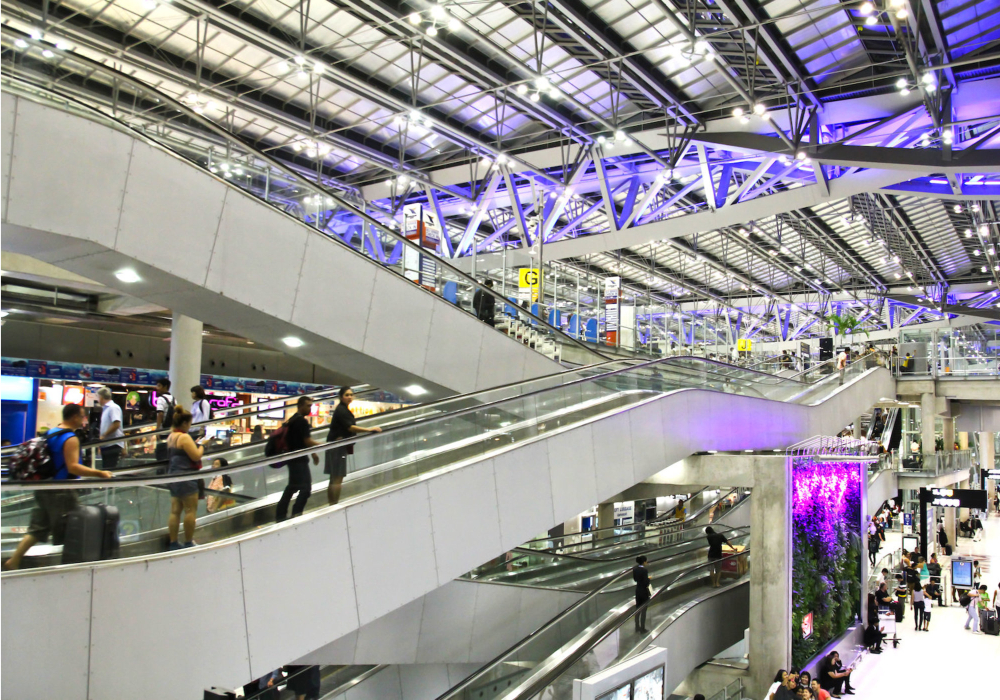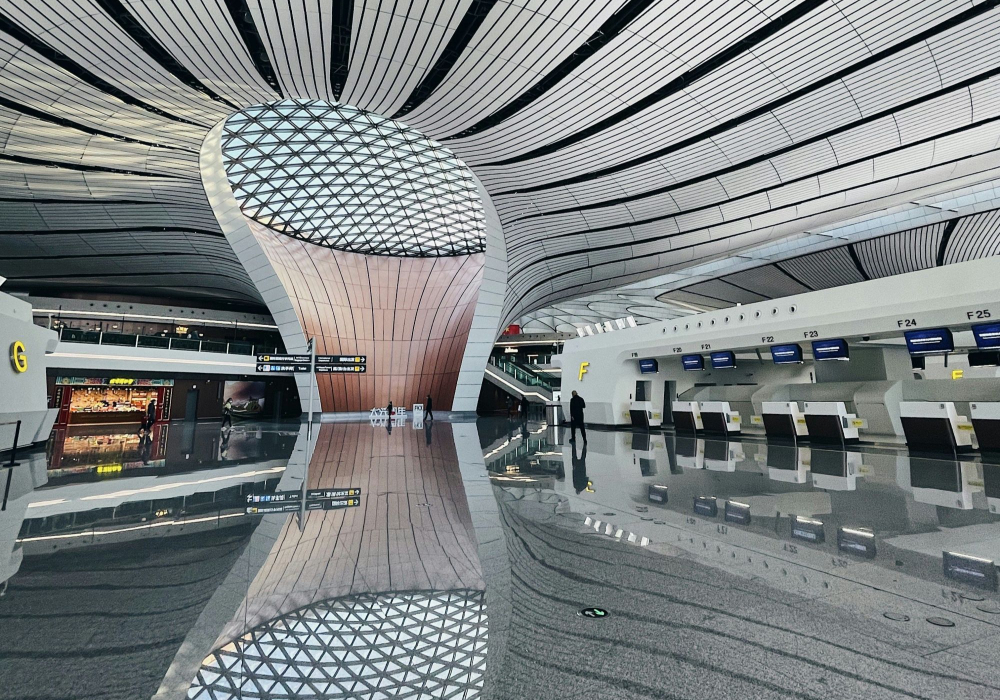Navigating airports stress-free is possible with these essential tips for seamless travel. With proper planning and organization, you can breeze through security and boarding without hassle.
Arrive early to allow ample time for check-in and security procedures. Utilize technology for mobile boarding passes and flight updates. Pack light and have essential documents easily accessible. Stay calm and flexible in case of unexpected delays. Following these tips can make your airport experience smooth and stress-free.
Plan ahead
Travelling through airports can often be a stressful experience. Long lines, crowded terminals, and unexpected delays can easily turn your trip into a nightmare. But with a little planning ahead, you can make your journey much smoother and enjoyable. Here, we share some essential tips to help you navigate airports stress-free.
Book flights In advance
Booking your flights well in advance is crucial for a hassle-free travel experience. Doing so offers numerous benefits:
- Better prices: Early bookings usually come with better deals and lower fares.
- Seat selection: You get more options for seat selection, ensuring a comfortable journey.
- Less stress: You avoid the last-minute scramble to find suitable flights.
Here's a simple table to show how booking early impacts flight prices:
| Booking time | Average price |
|---|---|
| 6 months before | $300 |
| 3 months before | $350 |
| 1 month before | $400 |
| Last minute | $500+ |
Booking early also allows you to more effectively plan your other travel details, such as accommodation and car rentals. Make sure to keep an eye out for promotions and discounts that airlines offer periodically.

Choose layover times wisely
Choosing the right layover time can make or break your travel experience. Here are some tips:
- Short layovers: Ensure you have enough time to reach your next gate. Airports can be large, and walking from one terminal to another can take time.
- Long layovers: If you have a long layover, consider exploring the city. Some airports offer layover tours that can be a great way to pass the time.
- Check airport facilities: Some airports have excellent amenities like lounges, spas, and even sleeping pods. Knowing what’s available can make a long layover much more pleasant.
Here's a quick checklist for layover planning:
- Check the airport map: Familiarize yourself with the layout to avoid getting lost.
- Monitor flight status: Keep an eye on the status of your connecting flight to prepare for any changes.
- Plan your meals: Know where the dining options are so you can grab a bite without rushing.
By choosing layover times wisely, you can turn what could be a stressful experience into a mini-adventure. Always aim for a balance between too-short and too-long layovers to ensure a smooth transition between flights.

Pack strategically
Travelling can be stressful, especially when navigating airports. Packing strategically can make your journey smoother and more enjoyable. By following a few key tips, you can minimize stress and maximize comfort during your trip. Focus on checking baggage guidelines, packing light, and bringing essentials in your carry-on to ensure a hassle-free travel experience.
Check baggage guidelines
Before you start packing, it's crucial to check your airline's baggage guidelines. Each airline has different rules regarding the size, weight, and number of bags you can bring.
Here are some key points to consider:
- Weight limits: Most airlines have a weight limit for both checked and carry-on bags. Ensure your bags do not exceed these limits to avoid extra fees.
- Size restrictions: Airlines often have specific size requirements for carry-on and checked luggage. Measure your bags to make sure they comply.
- Number of bags: Some airlines allow only one carry-on and one personal item. Check if your airline permits additional bags or charges for extra luggage.
- Prohibited items: Familiarize yourself with items that are not allowed in carry-on and checked luggage. This includes liquids, sharp objects, and certain electronics.
Refer to the table below for a quick reference of common baggage guidelines:
| Airline | Carry-On Weight Limit | Checked Bag Weight Limit | Number of Bags |
|---|---|---|---|
| Airline A | 7 kg | 23 kg | 1 Carry-On, 1 Personal Item |
| Airline B | 10 kg | 20 kg | 1 Carry-On, 1 Checked Bag |
| Airline C | 8 kg | 25 kg | 2 Checked Bags |
Pack light
Packing light can save you time and stress at the airport. Carrying fewer items means less to keep track of and a lighter load to carry.
Follow these tips to pack light:
- Choose versatile clothing: Select clothes that can be mixed and matched. Neutral colours and simple designs work best.
- Limit shoes: Shoes can take up a lot of space. Bring only two pairs – one for daily wear and one for special occasions.
- Use travel-sized toiletries: Bring only what you need. Travel-sized bottles save space and comply with liquid restrictions.
- Roll your clothes: Rolling clothes instead of folding them can save space and reduce wrinkles.
Consider using packing cubes to organize your items. Packing cubes can help maximize space and keep your belongings organized.
Here's a sample packing list for a 5-day trip:
- 5 tops
- 2 pairs of pants
- 1 dress/skirt
- 2 pairs of shoes
- Travel-sized toiletries
- Essential electronics (phone, charger, etc.)
Bring essentials in carry-on
Always have your essentials in your carry-on. This ensures that you have what you need even if your checked luggage is delayed or lost.
Here are some must-have items for your carry-on:
- Travel documents: Keep your passport, boarding pass, and any necessary visas handy.
- Valuables: Carry your valuables, such as jewelry and electronics, in your carry-on.
- Medications: Bring any medications you need, along with a copy of your prescriptions.
- Comfort items: Include a neck pillow, eye mask, and headphones for a more comfortable flight.
- Entertainment: Bring a book, tablet, or other forms of entertainment to pass the time.
- Snacks: Pack some snacks to keep you satisfied during your journey.
To keep these essentials organized, keep a small, easily accessible bag within your carry-on. This way, you can quickly grab what you need without rummaging through your entire bag.
By following these tips and packing strategically, you can navigate airports with ease and enjoy a stress-free travel experience.
Get to the airport early
Getting to the airport early is crucial for stress-free travel. It allows you to handle unexpected situations like traffic jams or long security lines. Knowing you have ample time helps you stay calm and enjoy the journey. Let's explore the importance of getting to the airport early and how to make it a habit.
Check airport transportation options
Always check your transportation options ahead of time. This will help you avoid last-minute surprises. Here are some popular options:
- Ride-sharing services: Services like Uber or Lyft can get you to the airport quickly.
- Public transportation: Buses, trains, and subways are often cheaper and can be reliable.
- Shuttle services: Many hotels offer free or low-cost shuttle services to the airport.
- Parking at the airport: If you drive, check the airport's parking options. Some airports have long-term parking lots with shuttle services.
Here’s a quick comparison table to help you decide:
| Option | Cost | Convenience |
|---|---|---|
| Ride-sharing | High | High |
| Public transportation | Low | Medium |
| Shuttle services | Low | High |
| Airport parking | Medium | High |
Arrive 2 hours before domestic flights
For domestic flights, arriving at the airport two hours early is ideal. This gives you enough time to check-in, go through security, and find your gate.
Here’s what you can do with those two hours:
- Check-in: Use self-service kiosks to speed up the process.
- Security: Be prepared for security checks. Remove shoes, belts, and laptops.
- Relax: Use the remaining time to relax. Grab a coffee or read a book.
Check your airline’s guidelines for specific instructions. Some airlines recommend arriving even earlier during busy travel seasons.

Arrive 3 hours before international flights
International flights require more time due to additional security checks and customs procedures. Arrive three hours early to ensure a smooth experience.
Steps to follow:
- Check-in: Complete all check-in formalities. International check-ins can take longer.
- Security and Customs: Go through security and customs checks. Be ready with all necessary documents.
- Relax: Spend the remaining time exploring duty-free shops or having a meal.
Here’s a quick list of things to remember:
- Have all travel documents ready.
- Be aware of different rules for liquids and electronics.
- Check the airport layout beforehand to find your gate easily.
Following these tips can make your international travel experience more enjoyable and stress-free.
Navigating security
Travelling through airports can be daunting, especially navigating security. The key to a stress-free experience is preparation. Knowing what to expect and how to streamline the process can make a huge difference. Here are some essential tips for navigating airport security efficiently.
Wear easy-to-remove shoes
Security checkpoints often require you to remove your shoes. Wearing easy-to-remove shoes can save you time and hassle. Opt for slip-ons or shoes with minimal lacing. This way, you can quickly take them off and put them back on without holding up the line.
- Slip-on shoes: These are the easiest to remove and put back on.
- Loafers or flats: Comfortable and easy to manage.
- Avoid boots: They take longer to remove and wear again.
Make sure your socks are in good condition, as you might be walking on the bare airport floor. Consider bringing a pair of disposable foot covers if you're concerned about hygiene. Wearing easy-to-remove shoes speeds up your process and helps others wait in line.
Prepare your carry-on for screening
Organizing your carry-on can significantly speed up the screening process. Pack items logically and accessibly. Place items you'll need to remove at the top or in accessible pockets. Liquids, electronics, and documents should be easily reachable.
- Liquids: Follow the 3-1-1 rule. Each liquid must be in a 3.4-ounce container, all containers in a 1-quart bag, one bag per passenger.
- Electronics: Place laptops, tablets, and e-readers in an accessible spot.
- Documents: Keep your boarding pass and ID ready for inspection.
| Item | Location |
|---|---|
| Liquids | Top pocket |
| Laptop | Separate compartment |
| Boarding Pass & ID | Front pocket |
Being organized will help you pass through security quickly and smoothly, reducing stress and making the experience more pleasant for everyone.
Know what is prohibited
Understanding what items are prohibited can save you from delays and confiscations. Familiarize yourself with the TSA's list of prohibited items. Common prohibited items include:
- Sharp objects: Knives, scissors, and razors.
- Flammable items: Lighters, fireworks, and aerosol sprays.
- Large liquids: Any liquid over 3.4 ounces.
Some items are allowed in checked baggage but not in carry-ons. Check the TSA guidelines for items like batteries, tools, and sports equipment. If you're unsure about an item, it's better to leave it at home or pack it in your checked luggage.
Here's a quick reference table for what you can and cannot bring:
| Item | Carry-On | Checked Baggage |
|---|---|---|
| Scissors (under 4 inches) | Allowed | Allowed |
| Liquids (over 3.4 ounces) | Prohibited | Allowed |
| Fireworks | Prohibited | Prohibited |
Knowing what is prohibited will help you pack smartly and avoid unnecessary delays at security checkpoints.
Stay informed
Travelling can be stressful, but staying informed helps make it easier. This section offers tips to stay updated and informed during your airport journey. By checking your flight status, downloading airline apps, and staying connected with airport services, you can travel stress-free.
Check flight status regularly
Checking your flight status is crucial to avoid surprises. Airlines often face delays or changes due to various reasons. Knowing your flight status keeps you ahead of any disruptions.
Here are some tips to keep track of your flight status:
- Check your email for updates from your airline.
- Visit the airline's website for the latest information.
- Use flight tracking websites like FlightAware or FlightRadar24.
At the airport, monitor the flight information display screens frequently. These screens provide real-time updates about gate changes, delays, and boarding times.
Consider signing up for text or email alerts from your airline. These alerts notify you of any significant changes to your flight schedule.
Being proactive and checking your flight status regularly ensures you stay informed and stress-free during your travel.
Download airline apps
Airline apps provide a convenient way to access flight information. These apps often offer real-time updates, mobile boarding passes, and more. Downloading your airline's app can save you time and stress.
Here are some benefits of using airline apps:
- Receive real-time notifications about flight changes.
- Access your mobile boarding pass without printing.
- Check in online and choose your seat.
- Track your baggage and know where it is at all times.
Popular airline apps include:
| Airline | App Name |
|---|---|
| American Airlines | American Airlines App |
| Delta | Fly Delta |
| United Airlines | United App |
Ensure you have the app downloaded and logged in before arriving at the airport. This preparation helps you access all features quickly and easily.
Stay connected with airport services
Staying connected with airport services ensures you have the latest information about your flight and airport amenities.
Here’s how you can stay connected:
- Follow the airport’s social media accounts for updates.
- Check the airport's website for maps and services.
- Use the airport's free Wi-Fi to access information quickly.
Many airports offer dedicated apps that provide detailed information about terminals, gates, and services.
Examples of useful airport apps include:
| Airport | App Name |
|---|---|
| Heathrow | Heathrow Airport Guide |
| LAX | Fly LAX |
| JFK | JFK Airport |
Using these resources helps you stay informed about any changes or updates. Staying connected with airport services ensures a smooth and stress-free travel experience.
Take care of yourself
Travelling through airports can be quite stressful. Long lines, security checks, and layovers can make anyone anxious. It's important to take care of yourself during this time. Self-care can make your journey more pleasant and less tiring. Here are some practical tips to keep you feeling your best.
Stay hydrated
Staying hydrated is crucial when you travel. Airplane cabins have low humidity levels, which can dehydrate you quickly. Always keep a water bottle with you. Most airports have water fountains where you can refill your bottle. This not only keeps you hydrated but also helps the environment by reducing plastic waste.
- Carry a reusable water bottle: Many airports have water refill stations.
- Avoid alcohol and caffeine: They can dehydrate you further.
- Drink water regularly: Take small sips throughout the day.
Here's a quick comparison of drinks that can affect your hydration levels:
| Drink | Hydration Level |
|---|---|
| Water | High |
| Juice | Medium |
| Coffee | Low |
| Alcohol | Very Low |
Stretch and move around
Sitting for long periods can make your muscles stiff and sore. Stretching and moving around can help. Walk around the terminal if you have time before your flight. This keeps your blood circulating and reduces the risk of blood clots.
- Simple stretches: Reach for the sky, twist your torso, and touch your toes.
- Walk around: Aim for at least 5-10 minutes of walking every hour.
- Use stairs: Instead of escalators, use stairs to get some extra movement.
Here's a list of easy stretches to do at the airport:
- Neck Rolls: Roll your neck in a circular motion.
- Shoulder Shrugs: Lift your shoulders up and down.
- Leg Stretches: Extend your leg and reach for your toes.
Bring healthy snacks
Airport food can be pricey and unhealthy. Bringing your own snacks ensures you have something nutritious to eat. Choose snacks that are easy to carry and don't need refrigeration. This will keep your energy levels up without the sugar crash.
- Nuts and seeds: Rich in protein and healthy fats.
- Fruit: Apples, bananas, and berries are great options.
- Granola bars: Choose ones with low sugar and high fiber.
Here are some healthy snack ideas:
| Snack | Benefits |
|---|---|
| Almonds | High in protein and fiber |
| Apple slices | Rich in vitamins and minerals |
| Greek yogurt | Good source of protein |
| Carrot sticks | Low in calories, high in vitamins |
By taking care of yourself, you can navigate airports with ease and enjoy your journey.
Entertainment and distractions
Airports can be stressful with long waits and unpredictable delays. Keeping yourself entertained is key to reducing stress and passing the time smoothly. This section provides tips on how to stay engaged and entertained while waiting for your flight.
Bring a good book or e-reader
Reading can be a wonderful escape from the hustle and bustle of airports. Having a good book or an e-Reader loaded with your favorite titles can make waiting times feel shorter.
Why bring a book or e-reader?
- They are lightweight and easy to carry.
- You can choose from a wide range of genres.
- They help you relax and unwind.
Recommended genres for airport reading:
| Genre | Why It's Great |
|---|---|
| Mystery/thriller | Keeps you engaged and guessing. |
| Romance | Light and easy to read. |
| Science fiction | Perfect for escaping reality. |
Choose a book or download e-books before your trip to ensure you have plenty of reading material.
Download movies or TV shows
Watching movies or TV shows can make time fly by. Be sure to download your favourite shows or new releases before arriving at the airport.
Benefits of downloading movies or TV shows:
- No need for internet access.
- Wide variety of choices.
- Can watch at your own pace.
Steps to download movies or TV shows:
- Choose your favourite streaming service.
- Find the movies or shows you want to watch.
- Download them to your device.
- Ensure your device is fully charged.
Always have a pair of good headphones to avoid disturbing others. This will also enhance your viewing experience.
Play mobile games
Mobile games are another excellent way to stay entertained at the airport. With thousands of games available, you can easily find something that suits your taste.
Why play mobile games?
- They are interactive and engaging.
- You can play offline or online.
- They offer a wide variety of genres.
Popular mobile game genres:
| Genre | Popular Games |
|---|---|
| Puzzle | Candy Crush, Tetris |
| Strategy | Clash of Clans, Plants vs. Zombies |
| Adventure | Temple Run, Subway Surfers |
Download a few games before heading to the airport to ensure you have plenty of options to keep you entertained.
Final tips
When it comes to travelling through airports, the final tips can make a significant difference in ensuring a stress-free journey. By following these last-minute guidelines, you can navigate airports with ease and peace of mind.
Be courteous to staff and fellow travellers
Being courteous to airport staff and your fellow travellers can enhance your overall airport experience. Simple acts of kindness and respect go a long way in creating a positive environment for everyone. Here are some ways to show courtesy:
- Smile and greet staff members
- Use "please" and "thank you" when interacting
- Avoid pushing or cutting in line
- Respect personal space and boundaries
Don't hesitate to ask for help
If you find yourself feeling lost or confused in the airport, don't hesitate to ask for assistance. Airport staff are there to help you navigate the terminals and address any concerns you may have. Asking for help when needed can save you time and reduce anxiety. Remember:
- Look for information desks or customer service counters
- Seek assistance from airline representatives
- Don't be afraid to ask fellow travellers for directions
- Clarify any doubts or questions promptly
Take a deep breath and stay calm
During busy travel times, it's common to feel overwhelmed or stressed. Remember to take a deep breath and stay calm throughout your airport journey. Maintaining a sense of composure allows you to approach any challenges with a clear mind and positive attitude. Here are some ways to stay calm:
- Practice deep breathing exercises
- Listen to calming music or podcasts
- Focus on the present moment and stay mindful
- Avoid rushing and allow extra time for unexpected delays
Mastering airport navigation significantly reduces travel stress. Use these tips to enhance your experience: Plan ahead, stay organized, and remain calm. Enjoy smoother and more enjoyable journeys. Remember, preparation is key. Happy travels!




Comments powered by CComment